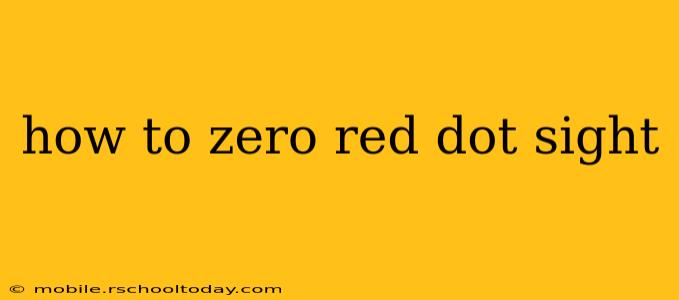Zeroing a red dot sight is crucial for accurate shooting. Whether you're a seasoned marksman or a first-time shooter, understanding this process ensures your shots land where you aim. This comprehensive guide will walk you through the steps, covering different scenarios and troubleshooting common issues.
Understanding the Basics of Zeroing
Before we dive into the specifics, let's clarify what "zeroing" means. Zeroing a red dot sight is the process of adjusting the sight's point of impact (POI) to match your point of aim (POA). In essence, you're aligning the red dot with where your bullet will strike the target at a specific distance. This is typically done at 25 yards (23 meters) for handguns and 25 or 50 yards (23 or 46 meters) for rifles, though the ideal distance depends on your weapon and intended use.
Key Terms to Know:
- Point of Aim (POA): Where you are aiming your weapon.
- Point of Impact (POI): Where your bullet actually hits the target.
- Windage: Adjusts the sight horizontally (left or right).
- Elevation: Adjusts the sight vertically (up or down).
- Clicks: The incremental adjustments you make to the windage and elevation knobs. Each click typically corresponds to a specific MOA (Minute of Angle) or other measurement unit, specific to your red dot sight. Check your sight's manual for precise details.
Step-by-Step Zeroing Process
This process assumes you're using a firearm with a properly functioning action and ammunition. Always prioritize safety. Never point a firearm at anything you don't intend to shoot.
-
Prepare your shooting area: Find a safe, controlled environment with a clear backstop. Ensure you have a stable shooting rest (like a bench rest) for consistent aim.
-
Secure your target: Place a target at your chosen zeroing distance (25 yards for handguns, 25 or 50 yards for rifles). Use a target with clear aiming points.
-
Mount the red dot sight: Make sure your red dot sight is securely mounted on your firearm according to the manufacturer's instructions.
-
Initial Sight-in Shots: Fire a few shots at the target, aiming at the center. Observe where the shots are impacting relative to your point of aim. This gives you a baseline.
-
Adjust Windage and Elevation: Based on your initial shots, adjust the windage and elevation knobs on your red dot sight. If the shots are consistently to the right, adjust the windage knob to the left. If they're high, adjust the elevation knob down. The number of clicks needed will depend on your sight and the amount of adjustment required. Refer to your sight's manual for click value information.
-
Refine Your Zero: After making adjustments, fire another group of shots. Repeat steps 5 and 6 until your point of impact is centered on your point of aim. Remember to make small adjustments at a time to avoid overcorrection.
-
Verify your Zero: After achieving a satisfactory zero, fire a final group of shots to verify accuracy.
Troubleshooting Common Issues
- Consistent misses to one side: This usually indicates an issue with windage.
- Consistent high or low shots: This points to an elevation problem.
- Large shot groups: This could indicate a problem with your shooting technique, ammunition, or firearm itself.
Beyond the Basics: Factors Affecting Zero
Several factors can influence the accuracy of your zero. These include:
- Ammunition: Different ammunition types can lead to variations in point of impact.
- Environmental conditions: Wind, temperature, and altitude can all affect your shot trajectory.
- Shooting technique: Inconsistent grip, stance, and trigger pull can lead to inaccurate shots.
It's important to remember that your zero may need to be rechecked periodically, especially after cleaning your firearm or changing ammunition.
This guide provides a comprehensive overview of zeroing a red dot sight. Always consult your specific red dot sight and firearm manuals for detailed instructions and safety precautions. Remember to practice regularly and maintain safe gun handling procedures at all times.
